Spatiotemporal Analysis of Vegetation Cover in Relation to Its Driving Forces in Qinghai–Tibet Plateau
Abstract
:1. Introduction
2. Data Sources and Research Methods
2.1. Study Area Overview
2.2. Data Sources
2.2.1. NDVI Data
2.2.2. Climate Data
2.2.3. Resource Data
2.3. Research Methodology
2.3.1. Mann–Kendall Test
2.3.2. Trend Analysis and Theil–Sen Trend Slope Estimation
2.3.3. Pearson Correlation Analysis
2.3.4. Geodetector Calculation
3. Results
3.1. Characteristics of Temporal Changes in Vegetation Cover
3.2. Spatial Variation Characteristics of Vegetation Cover
3.3. Trend Analysis of Vegetation Cover Change
3.4. Effect of Climate Factors on Vegetation Cover
3.5. Analysis of the Influence of Each Driver on Vegetation Cover Change
4. Discussion and Conclusions
4.1. Discussion
4.2. Conclusions
Author Contributions
Funding
Institutional Review Board Statement
Informed Consent Statement
Data Availability Statement
Conflicts of Interest
References
- Cao, M.; Woodward, F.I. Dynamic responses of terrestrial ecosystem carbon cycling to global climate change. Nature 1998, 393, 249–252. [Google Scholar] [CrossRef]
- Zhang, G.L.; Xu, X.L.; Zhou, C.P.; Zhang, H.B.; Ouyang, H. Responses of vegetation changes to climatic variations in Hulun Buir grassland in past 30 years. Acta Geogr. Sin. 2011, 66, 47–58. [Google Scholar]
- Piao, S.; Mohammat, A.; Fang, J.; Cai, Q.; Feng, J. NDVI-based increase in growth of temperate grasslands and its responses to climate changes in China. Glob. Environ. Chang. 2006, 16, 330–348. [Google Scholar] [CrossRef]
- Yao, T.; Chen, F.; Cui, P.; Ma, Y.; Xu, B.; Zhu, L.; Zhang, F.; Wang, W.; Ai, L.; Yang, X. From Tibetan Plateau to Third Pole and Pan-third Pole. Bull. Chin. Acad. Sci. 2017, 32, 924–931. [Google Scholar]
- Zhang, R.; Su, F.; Jiang, Z.; Gao, X.J.; Guo, D.L.; Ni, J.; You, Q.L.; Lan, C.; Zhou, B.T. An overview of projected climate and environmental changes across the Tibetan Plateau in the 21st century. Chin. Sci. Bull. 2015, 60, 3036–3047. [Google Scholar]
- Alley, R.B.; Meese, D.A.; Shuman, C.A.; Gow, A.J.; Taylor, K.C.; Grootes, P.M.; White, J.W.C.; Ram, M.; Waddington, E.D.; Mayewski, P.A.; et al. Abrupt increase in Greenland snow accumulation at the end of the Younger Dryas event. Nature 1993, 362, 527–529. [Google Scholar] [CrossRef]
- Li, S.C.; Wu, J.S.; Gong, J.; Li, S. Human footprint in Tibet: Assessing the spatial layout and effectiveness of nature reserves. Sci. Total Environ. 2018, 621, 18–29. [Google Scholar] [CrossRef] [PubMed]
- Wang, X.H.; Zheng, D.; Shen, Y.C. Land use change and its driving forces on the Tibetan Plateau during 1990–2000. Catena 2008, 72, 56–66. [Google Scholar] [CrossRef]
- Ichii, K.; Kawabata, A.; Yamaguchi, Y. Global correlation analysis for NDVI and climatic variables and NDVI trends: 1982–1990. Int. J. Remote Sens. 2002, 23, 3873–3878. [Google Scholar] [CrossRef]
- Mao, D.; Wang, Z.; Luo, L.; Ren, C. Integrating AVHRR and MODIS data to monitor NDVI changes and their relationships with climatic parameters in Northeast China. Int. J. Appl. Earth Obs. Geoinf. 2012, 18, 528–536. [Google Scholar] [CrossRef]
- Lu, Q.Q.; Jiang, T.; Liu, D.L.; Liu, Z.Y. The response characteristics of NDVI with different vegetation cover types to temperature and precipitation in China. Ecol. Environ. Sci. 2020, 29, 23–34. [Google Scholar]
- Yonaba, R.; Koïta, M.; Mounirou, L.; Tazen, F.; Queloz, P.; Biaou, A.; Niang, D.; Zouré, C.; Karambiri, H.; Yacouba, H. Spatial and transient modelling of land use/land cover (LULC) dynamics in a Sahelian landscape under semi-arid climate in northern Burkina Faso. Land Use Policy 2021, 103, 105305. [Google Scholar] [CrossRef]
- Wang, X.Y.; Lian, J.; Yang, X.P.; Zhao, X.Y.; Wang, X.J.; Ma, Z.W.; Gong, C.K.; Qu, H.; Wang, B. Variation in vegetation and its response to environmental factors in Maqu County. Acta Ecol. Sin. 2019, 39, 923–935. [Google Scholar]
- Xu, M.H.; Xue, X. Correlation among vegetation characteristics, temperature and moisture of alpine meadow in the Qinghai-Tibetan Plateau. Acta Ecol. Sin. 2013, 33, 3158–3168. [Google Scholar]
- Liang, H.; Huang, S.; Meng, E.; Huang, Q. Runoff prediction based on multiple hybrid models. J. Hydraul. Eng. 2020, 51, 112–125. [Google Scholar]
- Mao, H.; Yan, Y.; Zhang, J. The present situation and prospect of the hydrographic forecasting methods. J. Libr. Inf. Sci. 2005, 15, 172–173. [Google Scholar]
- Chen, M.; Lu, W.; Hou, Z.; Huang, H.; Li, P. The assesement of groundewater quality based on support vector machine in Western Jilin. Water Sav. Irrig. 2013, 38, 29–33. [Google Scholar]
- Ma, Y.; Huang, Z.X. Study on spatial-temporal evolution and measurement of green development index of urban agglomerations in the middle reaches of Yangtze River: GWR model based. Ecol. Environ. Sci. 2017, 26, 794–807. [Google Scholar]
- Evans, J.; Geerken, R. Discrimination between climate and human-induced dryland degradation. J. Arid Environ. 2004, 57, 535–554. [Google Scholar] [CrossRef]
- Wessels, K.J.; Prince, S.D.; Malherbe, J.; Small, J.; Frost, P.; VanZyl, D. Can human-induced land degradation be distinguished from the effects of rainfall variability? A case study in South Africa. J. Arid Environ. 2007, 68, 271–297. [Google Scholar] [CrossRef]
- Zhao, S.; Wu, X.Q.; Zhou, J.X.; Pereira, P. Spatiotemporal tradeoffs and synergies in vegetation vitality and poverty transition in rocky desertification area. Sci. Total Environ. 2021, 752, 13. [Google Scholar] [CrossRef] [PubMed]
- Zhu, L.; Meng, J.; Zhu, L. Applying Geodetector to disentangle the contributions of natural and anthropogenic factors to NDVI variations in the middle reaches of the Heihe River Basin. Ecol. Indic. 2020, 117, 106545. [Google Scholar] [CrossRef]
- Gbohoui, Y.P.; Paturel, J.-E.; Tazen, F.; Mounirou, L.A.; Yonaba, R.; Karambiri, H.; Yacouba, H. Impacts of climate and environmental changes on water resources: A multi-scale study based on Nakanbé nested watersheds in West African Sahel. J. Hydrol. Reg. Stud. 2021, 35, 100828. [Google Scholar] [CrossRef]
- Zhang, Y.L.; Liu, L.S.; Wang, Z.F.; Bai, W.; Ding, M.; Wang, X.; Yan, J.; Xu, E.; Wu, X.; Zhang, B.; et al. Spatial and temporal characteristics of land use and cover changes in the Tibetan Plateau. Chin. Sci. Bull. 2019, 64, 2865–2875. [Google Scholar]
- Xu, X. Annual Vegetation Index (NDVI) Spatial Distribution Dataset in China. Data Registration and Publication System of the Data Center for Resource and Environmental Sciences, Chinese Academy of Sciences. 2018. Available online: https://www.resdc.cn/DOI/doi.aspx?DOIid=49 (accessed on 1 July 2023). [CrossRef]
- Peng, S.; Ding, Y.; Liu, W.; Li, Z. 1 km monthly temperature and precipitation dataset for China from 1901 to 2017. Earth Syst. Sci. Data 2019, 11, 1931–1946. [Google Scholar] [CrossRef]
- Xu, X.; Liu, J.; Zhang, S.; Li, R.; Yan, C.; Wu, S. Multi-Period Land Use Remote Sensing Monitoring Dataset in China (CNLUCC). Data Registration and Publication System of the Data Center for Resource and Environmental Sciences, Chinese Academy of Sciences. 2018. Available online: https://www.resdc.cn/DOI/doi.aspx?DOIid=54 (accessed on 1 July 2023). [CrossRef]
- Tang, G. Digital Elevation Model of China (1 KM). A Big Earth Data Platform for Three Poles. 2019. Available online: https://data.tpdc.ac.cn/zh-hans/data/12e91073-0181-44bf-8308-c50e5bd9a734 (accessed on 1 July 2023).
- Ling, Y.I.; Xiong, L.Y.; Yang, X.H. Method of Pixelizing GDP Data Based on the GIS. J. Gansu Sci. 2006, 18, 54–58. [Google Scholar]
- Liu, H.; Jiang, D.; Yang, X.; Luo, C. Spatialization Approach to 1 km Grid GDP Supported by Remote Sensing. Geo-Inf. Sci. 2005, 7, 120–123. [Google Scholar]
- Huang, Y.; Bao, A.-M.; Chen, X.; Liu, H.L.; Yang, G.H. A study of regional GDP kilometer grid based on oasis land use. J. Glaciol. Geocryol. 2009, 31, 162–169. [Google Scholar]
- Xu, X. A Kilometer Grid Dataset of Spatial Distribution of Chinese Population. Data Registration and Publication System of the Data Center for Resource and Environmental Sciences, Chinese Academy of Sciences. 2017. Available online: https://www.resdc.cn/DOI/doi.aspx?DOIid=32 (accessed on 1 July 2023). [CrossRef]
- Chen, T.; Xia, J.; Zou, L.; Hong, S. Quantifying the influences of natural factors and human activities on NDVI changes in the Hanjiang River basin, China. Remote Sens. 2020, 12, 3780. [Google Scholar] [CrossRef]
- Li, P.; Wang, J.; Liu, M.; Xue, Z.; Bagherzadeh, A.; Liu, M. Spatio-temporal variation characteristics of NDVI and its response to climate on the Loess Plateau from 1985 to 2015. CATENA 2021, 203, 105331. [Google Scholar] [CrossRef]
- Jiang, W.; Yuan, L.; Wang, W.; Cao, R.; Zhang, Y.; Shen, W. Spatio-temporal analysis of vegetation variation in the Yellow River Basin. Ecol. Indic. 2015, 51, 117–126. [Google Scholar] [CrossRef]
- Zhao, W.; Gao, B.; Lu, Q.; Zhong, Z.-Q.; Liang, X.-M.; Liu, M.; Ma, S.-X.; Sun, J.-R.; Chen, L.-G.; Fan, S.-J. Ozone pollution trend in the Pearl River Delta region during 2006–2019. Environ. Sci. 2021, 42, 97–105. [Google Scholar]
- Mann, H.B. Nonparametric tests against trend. Econometrica 1945, 13, 245–259. [Google Scholar] [CrossRef]
- Kendall, M.G.; Stuart, A. The Advanced Theory of Statistics: Design and Analysis, and Time-Series; Charles Griffin & Company Limited: London, UK, 1968; Volume 3. [Google Scholar]
- Sen, P.K. Estimates of the regression coefficient based on Kendall’s tau. J. Am. Stat. Assoc. 1968, 63, 1379–1389. [Google Scholar] [CrossRef]
- Xing, Y.; He, Z.H. An NDVI-based analysis of the temporal and spatial characteristics of vegetation coverage in Guizhou province. J. S. China Norm. Univ. (Nat. Sci. Ed.) 2021, 53, 84–95. [Google Scholar]
- Wang, J.; Zhang, S.; Gao, Y. Current status and perspectives of research on the interrelationship between vegetation dynamics and environmental factors on the Qinghai-Tibet Plateau. Earth Sci. Front. 2021, 28, 70–82. [Google Scholar]
- Wang, J.F.; Xu, C.D. Geodetector: Principle and prospective. Acta Geogr. Sin. 2017, 72, 116–134. [Google Scholar]
- Miao, L.; Lu, Q.; Liu, G.L.; Wei, X.J. Spatial and temporal evolution characteristics of NDVI and its response to climate factors for different vegetation types on the Tibetan Plateau from 1999–2019. Res. Soil Water Conserv. 2023, 30, 97–105. [Google Scholar]
- Chen, H.; Ju, P.; Zhang, J.; Wang, Y.; Zhu, Q.; Yan, L.; Kang, X.; He, Y.; Zeng, Y.; Hao, Y.; et al. Attribution analyses of changes in alpine grasslands on the Qinghai-Tibetan Plateau. Chin. Sci. Bull. 2020, 65, 2406–2418. [Google Scholar] [CrossRef]
- Chen, J.H.; Wu, K.; Hu, C.M.; Yang, H. Spatial and temporal variability of vegetation sensitivity in the Tibetan Plateau during the growing season 2000–2021. Acta Ecol. Sin. 2023, 43, 4054–4065. [Google Scholar]
- Zhao, Q.Q.; Zhang, J.P.; Zhao, T.B.; Li, J.H. Vegetation changes and its response to climate change in China since 2000. Plateau Meteorol. 2021, 40, 292–301. [Google Scholar]
- Wang, Z.P.; Zhang, X.Z.; He, Y.T.; Li, M.; Shi, P.L.; Zu, J.X.; Niu, B. Responses of normalized difference vegetation index (NDVI) to precipitation changes on the grassland of Tibetan Plateau from 2000 to 2015. Chin. J. Appl. Ecol. 2018, 29, 75–83. [Google Scholar]
- Liu, Y.; Li, J. Geographical Detection and Optimal Decision Making of the Divergent Mechanism of Rural Poverty in Chinese Counties. Acta Geogr. Sin. 2017, 72, 161–173. [Google Scholar]
- Ji, Z.; Pei, T.; Chen, Y.; Hou, Q.Q.; Xie, B.P.; Wu, H.W. Spatial and temporal variation of NDVI in grasslands on the Qinghai-Tibet Plateau from 2001 to 2020 and analysis of the driving factors. Acta Agrestia Sin. 2022, 30, 1873–1881. [Google Scholar]
- Yuan, Q.; Yang, J. Phenological changes of grassland vegetation on the Qinghai-Tibet Plateau and its response to climate change. Chin. J. Grassl. 2021, 43, 32–43. [Google Scholar]
- Zhong, L.; Ma, Y.; Xue, Y.; Piao, S. Climate Change Trends and Impacts on Vegetation Greening Over the Tibetan Plateau. J. Geophys. Res. Atmos. 2019, 124, 7540–7552. [Google Scholar] [CrossRef]
- Wang, C.; Wang, J.; Naudiyal, N.; Wu, N.; Cui, X.; Wei, Y.; Chen, Q. Multiple Effects of Topographic Factors on Spatio-Temporal Variations of Vegetation Patterns in the Three Parallel Rivers Region, Southeast Qinghai-Tibet Plateau. Remote Sens. 2022, 14, 151. [Google Scholar] [CrossRef]
- Liu, N.; Peng, S.; Chen, Y. Temporal effects of climate factors on vegetation growth on the Tibetan Plateau. J. Plant Ecol. 2022, 46, 18–26. [Google Scholar]
- Li, P.; He, Z.; He, D.; Xue, D.; Wang, Y.; Cao, S. Fractional vegetation coverage response to climatic factors based on grey relational analysis during the 2000-2017 growing season in Sichuan Province, China. Int. J. Remote Sens. 2020, 41, 1170–1190. [Google Scholar] [CrossRef]
- Zhou, Y.K. Granger effect analysis of NDVI response of vegetation to climate factors on the Qinghai-Tibet Plateau. Progress. Geogr. 2019, 38, 718–730. [Google Scholar]
- Ma, Q.M.; Jia, X.P.; Wang, H.B.; Li, X.S.; Li, S.N. A review of methods for evaluating the effects of climate and anthropogenic factors on vegetation change. J. Desert Res. 2019, 39, 48–54. [Google Scholar]
- Zheng, K.; Tan, L.; Sun, Y.; Wu, Y.; Duan, Z.; Xu, Y.; Gao, C. Impacts of climate change and anthropogenic activities on vegetation change: Evidence from typical areas in China. Ecol. Indic. 2021, 126, 107648. [Google Scholar] [CrossRef]
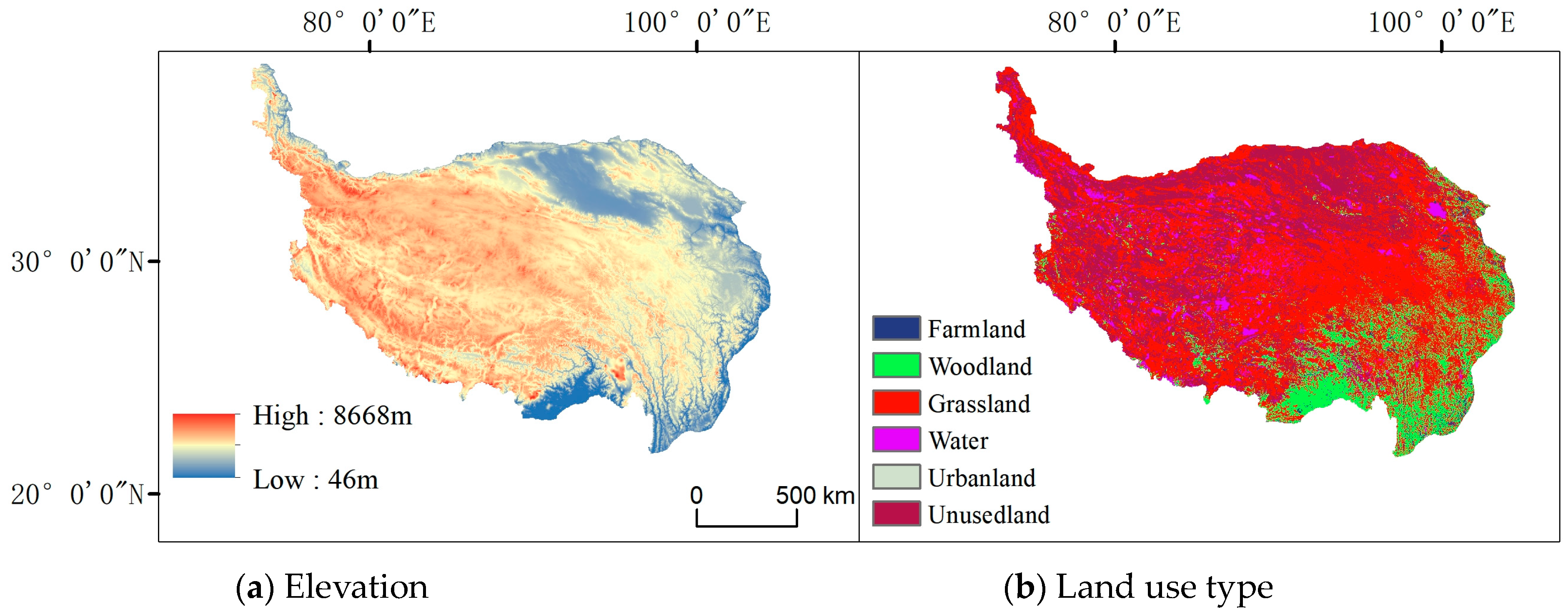
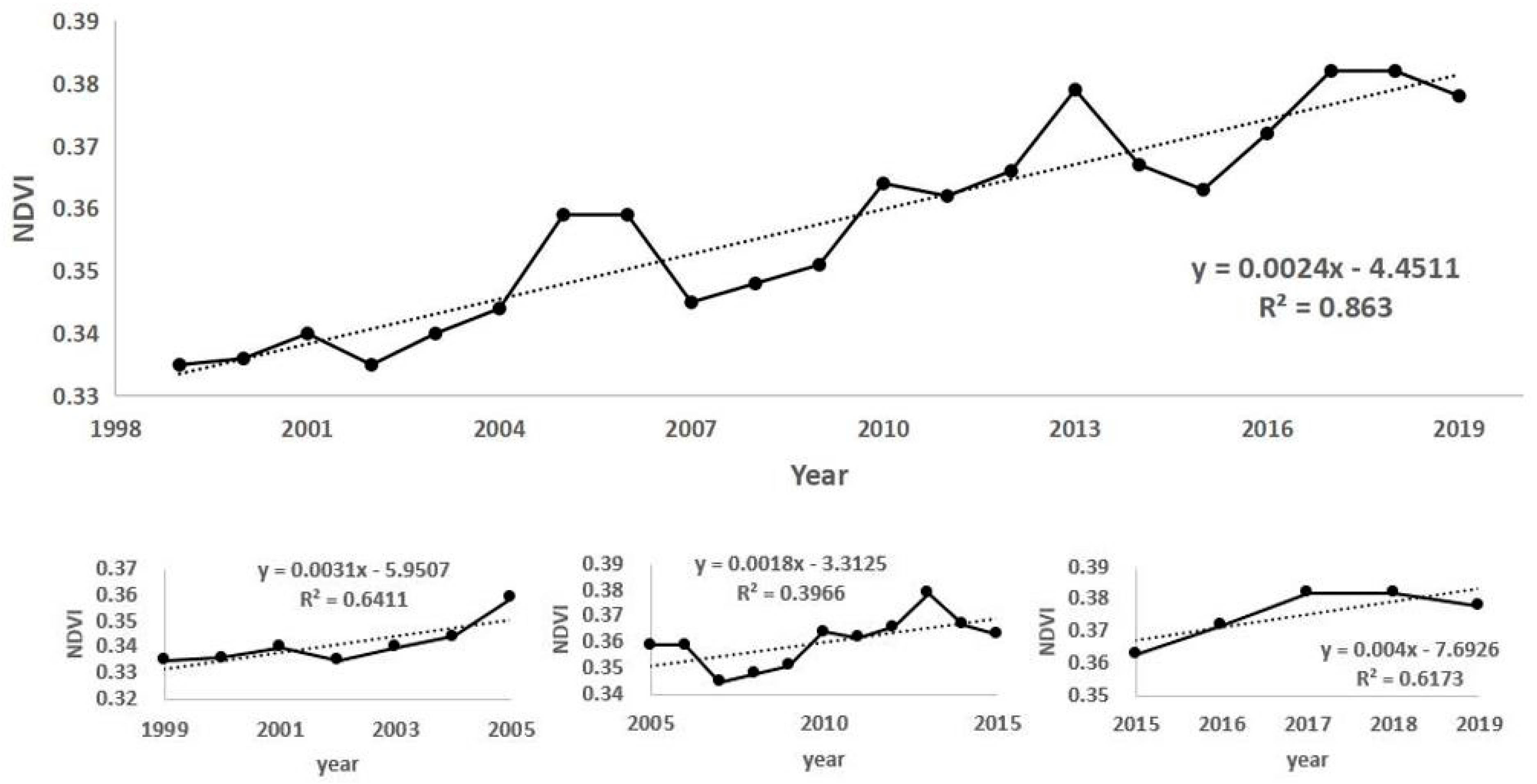

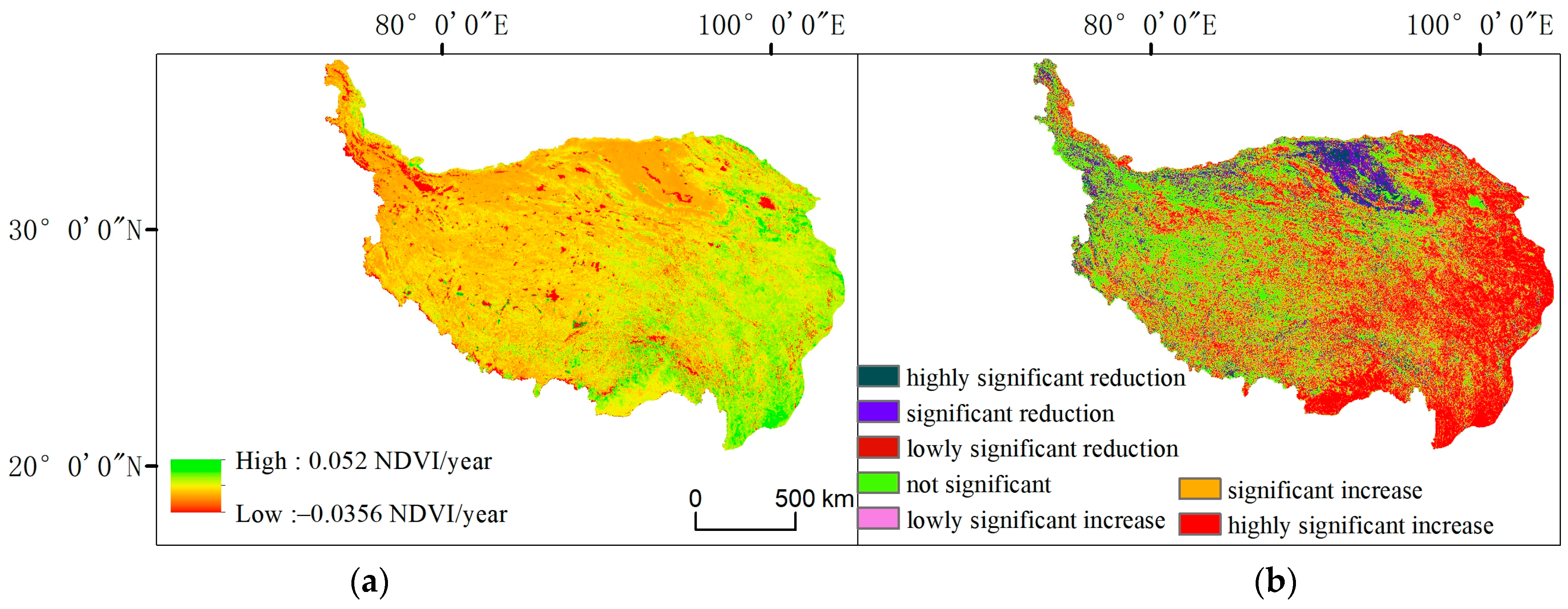
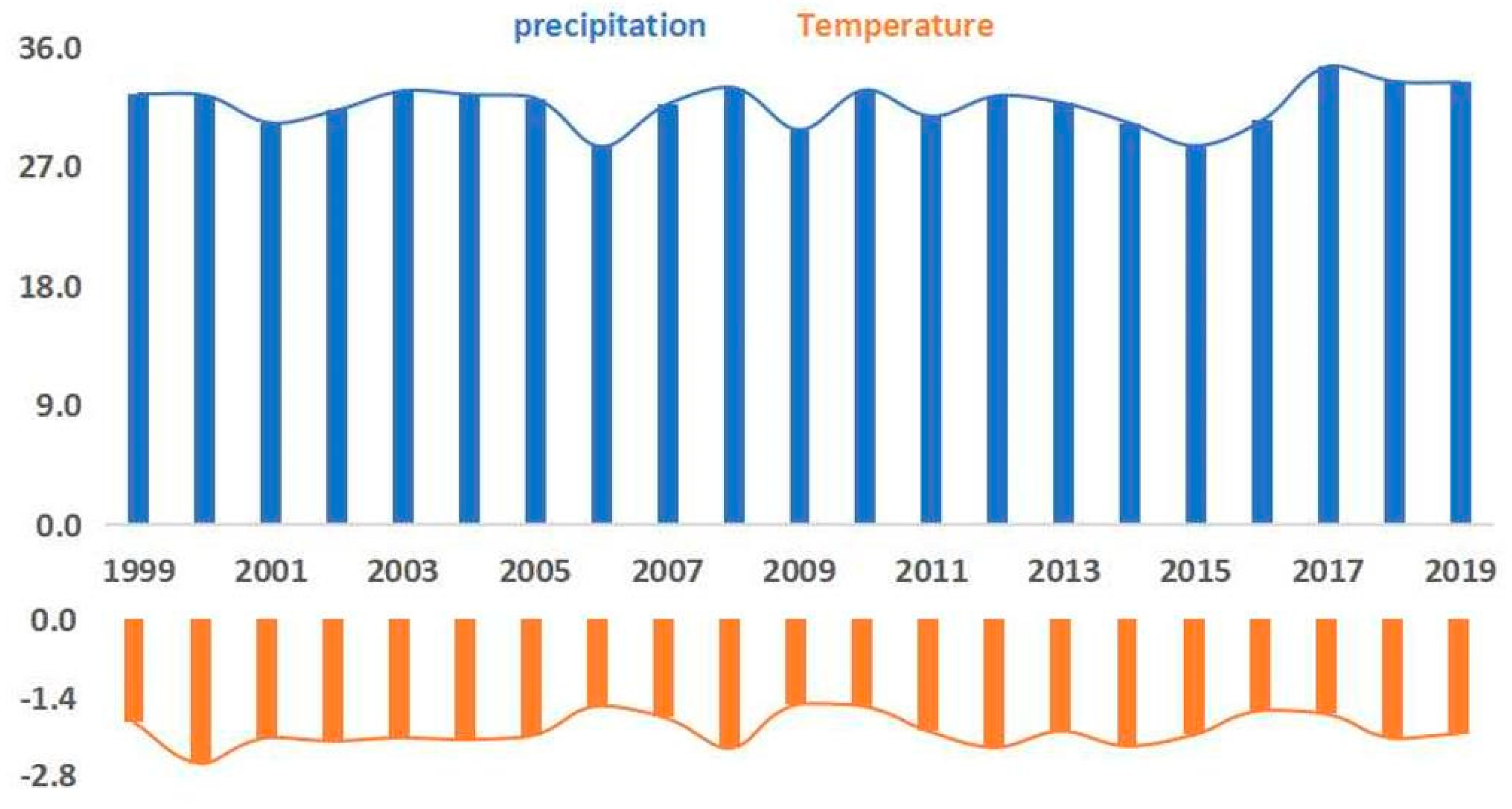


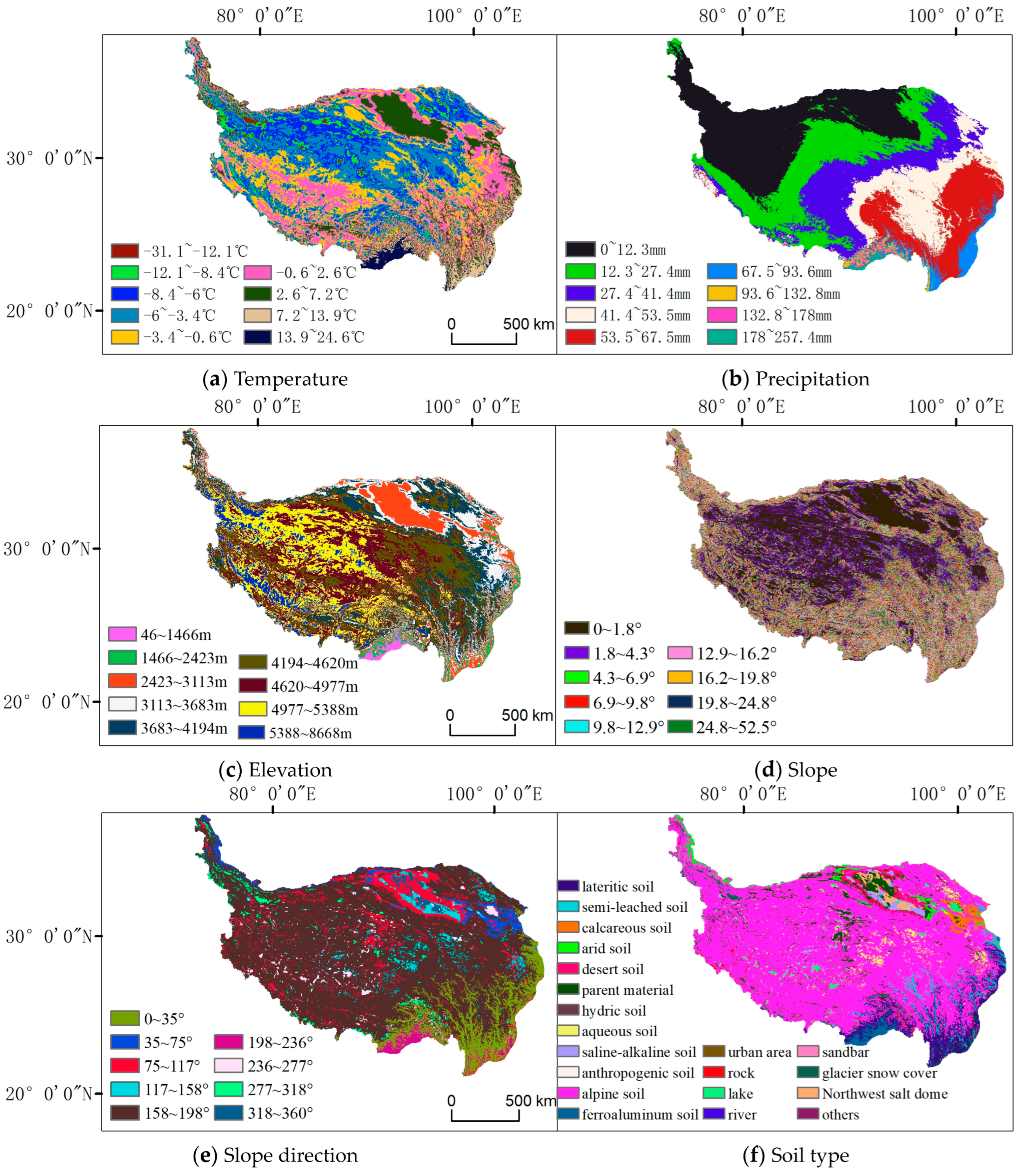
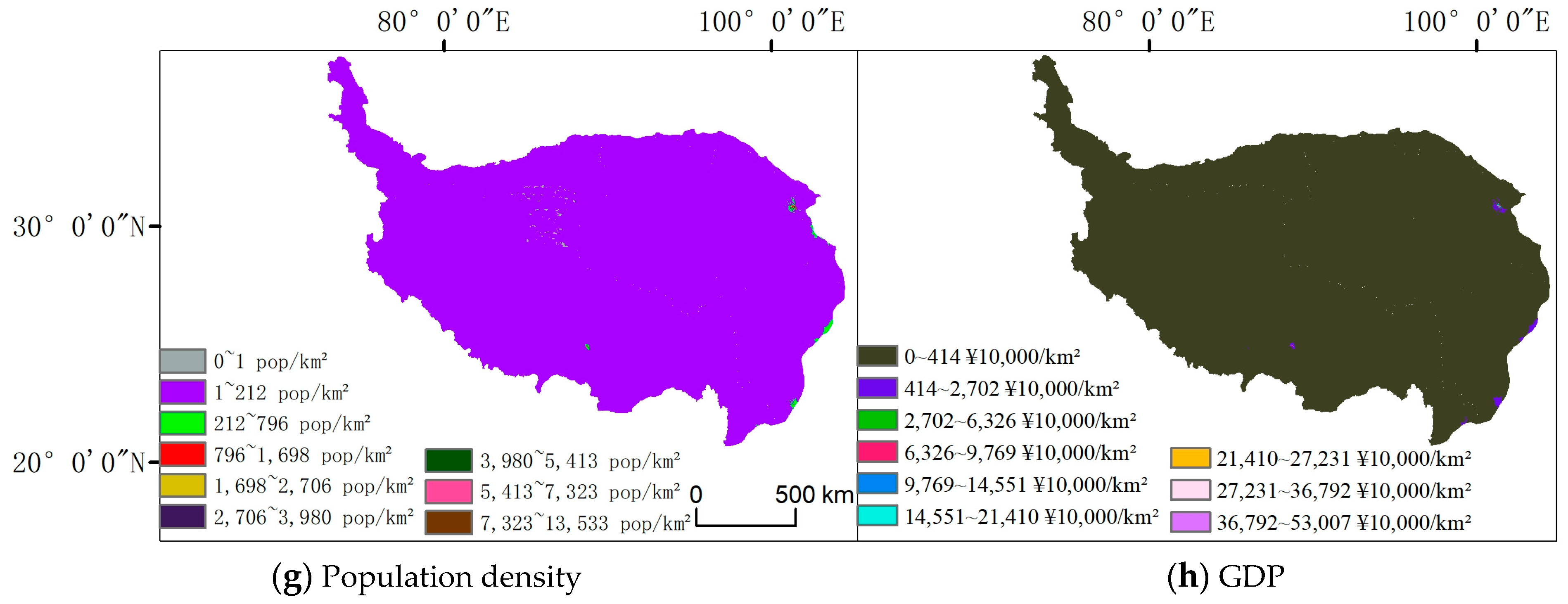
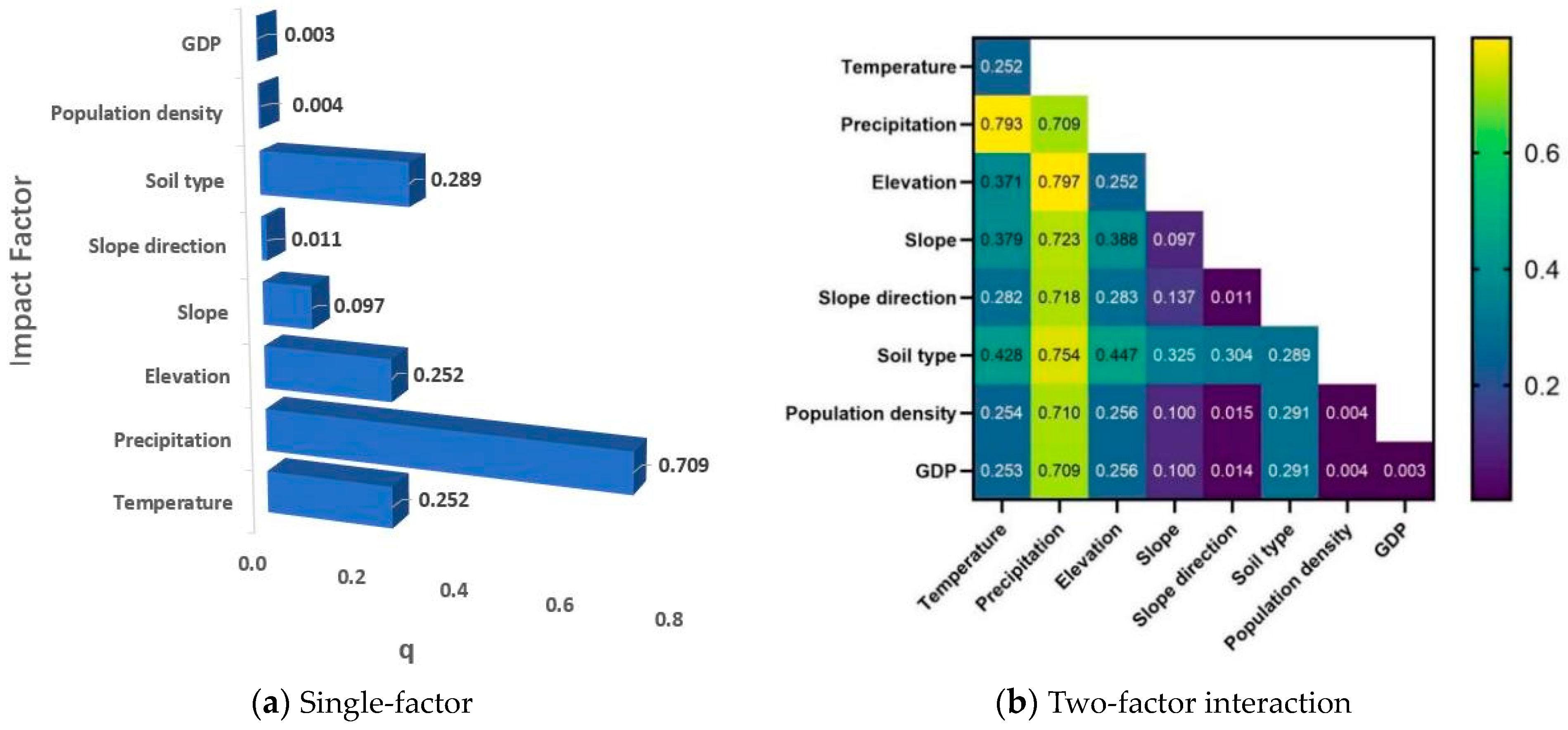
| Year | Low Vegetation Cover (0–0.3) | Low to Medium Vegetation Cover (0.3–0.6) | Medium Vegetation Cover (0.6–0.8) | High Vegetation Cover (>0.8) | ||||||||
|---|---|---|---|---|---|---|---|---|---|---|---|---|
| Area (km²) | Proportion (%) | Growth Rate (%) | Area (km²) | Proportion (%) | Growth Rate (%) | Area (km²) | Proportion (%) | Growth Rate (%) | Area (km²) | Proportion (%) | Growth Rate (%) | |
| 1999 | 147.3 | 57.3 | 48.8 | 19 | 55.3 | 21.5 | 5.4 | 2.1 | ||||
| 2004 | 145.7 | 56.7 | −1.09 | 47.5 | 18.5 | −2.66 | 52.7 | 20.5 | −4.70 | 11.1 | 4.3 | 105.56 |
| 2009 | 142.9 | 55.6 | −1.92 | 47.3 | 18.4 | −0.42 | 55 | 21.4 | 4.36 | 11.6 | 4.5 | 4.50 |
| 2014 | 139.8 | 54.4 | −2.17 | 46 | 17.9 | −2.75 | 38.8 | 15.1 | −29.45 | 32.6 | 12.7 | 181.03 |
| 2019 | 137.0 | 53.3 | −2.00 | 45.2 | 17.6 | −1.74 | 37.5 | 14.6 | −3.35 | 37.5 | 14.6 | 15.03 |
| Area (km2) | Proportion (%) | ||
|---|---|---|---|
| trend analysis | Decreasing trend | 83.800 | 32.64 |
| Increasing trend | 173.200 | 67.36 | |
| Significance Test | highly significant reduction | 8.000 | 3.14 |
| Significant reduction | 13.900 | 5.41 | |
| lowly significant reduction | 8.200 | 3.15 | |
| not significant change | 102.500 | 39.86 | |
| lowly significant increase | 12.100 | 4.67 | |
| Significant increase | 27.800 | 10.79 | |
| highly significant increase | 84.800 | 32.99 | |
| Temperature | Precipitation | ||||
|---|---|---|---|---|---|
| Area (km2) | Proportion (%) | Area (km2) | Proportion (%) | ||
| Relevance | negative correlation | 85.30 | 33.18 | 86.60 | 33.71 |
| positive correlation | 171.70 | 66.82 | 170.40 | 66.29 | |
| t-Test significance | highly significant reduction | 7.00 | 2.73 | 12.50 | 4.87 |
| significant reduction | 20.50 | 7.97 | 24.50 | 9.55 | |
| not significant change | 229.50 | 89.30 | 220.00 | 85.58 | |
Disclaimer/Publisher’s Note: The statements, opinions and data contained in all publications are solely those of the individual author(s) and contributor(s) and not of MDPI and/or the editor(s). MDPI and/or the editor(s) disclaim responsibility for any injury to people or property resulting from any ideas, methods, instructions or products referred to in the content. |
© 2023 by the authors. Licensee MDPI, Basel, Switzerland. This article is an open access article distributed under the terms and conditions of the Creative Commons Attribution (CC BY) license (https://creativecommons.org/licenses/by/4.0/).
Share and Cite
Xu, T.; Wu, H. Spatiotemporal Analysis of Vegetation Cover in Relation to Its Driving Forces in Qinghai–Tibet Plateau. Forests 2023, 14, 1835. https://doi.org/10.3390/f14091835
Xu T, Wu H. Spatiotemporal Analysis of Vegetation Cover in Relation to Its Driving Forces in Qinghai–Tibet Plateau. Forests. 2023; 14(9):1835. https://doi.org/10.3390/f14091835
Chicago/Turabian StyleXu, Tong, and Hua Wu. 2023. "Spatiotemporal Analysis of Vegetation Cover in Relation to Its Driving Forces in Qinghai–Tibet Plateau" Forests 14, no. 9: 1835. https://doi.org/10.3390/f14091835
APA StyleXu, T., & Wu, H. (2023). Spatiotemporal Analysis of Vegetation Cover in Relation to Its Driving Forces in Qinghai–Tibet Plateau. Forests, 14(9), 1835. https://doi.org/10.3390/f14091835





